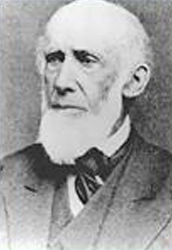
"A true engineer, first of all, considers his duties as a trust and directs his whole energies to discharge the trust with all the solemnity of a judge on a bench. He is so immersed in his profession that he has no other sources of amusement, and is therefore always on his post." from: Jervis Memoirs, Beach Transcript, Jervis Library, Rome, New York.
John B. Jervis was born in Huntington, Long Island, but spent most of his life in Rome, New York, where his family moved when he was three. He attended public schools until he was 15 and wanted to pursue higher education, but his family couldn't afford it. Instead, he worked for seven years on his father's farm. In 1817, with construction of the Erie Canal beginning, he took a job as an axeman, working under chief engineer Benjamin Wright (the "Father of American Civil Engineering"), which gave Jervis the opportunity to learn about engineering.
He soon demonstrated such proficiency that he was promoted to rodman, and two years later, to resident engineer overseeing some seven miles of the canal's length, at what then seemed a lucrative salary of $1.25 a day. By 1824, Jervis had risen to resident engineer for more than 50 miles of the canal. Benjamin Wright, with construction of the Erie Canal coming to an end, became chief engineer on the Delaware & Hudson Canal, used primarily to haul anthracite coal from mines in Carbondale, Pennsylvania, to New York City via the Hudson River. Wright remembered his former protege and offered Jervis a job as assistant engineer for this new project. The original plan was simply to build a canal and make various improvements to the river, but Jervis believed the 1,000-foot Moosic Mountains along the route couldn't be traversed that way. He proposed that the canal be augmented with a railway line using inclined planes where possible and steam-powered locomotives where necessary. To that end, he drew up specifications for locomotive procurement. With the help of Horatio Allen, the Stourbridge Lion was constructed in England and shipped to the site. Although the engine itself worked well, the Lion proved too heavy for the trestles that had been constructed along the route and the engine was abandoned. Jervis, however, did not lose interest in locomotives and later developed the first engine with its front wheels on a swiveling "bogie" truck that enabled it to travel around curves at high speed without derailing.
His later engine design, "The Experiment," was at the time (1832) the fastest locomotive in the world, with a top speed of about 80 miles an hour. Once the Delaware & Hudson Canal was completed in 1833, Jervis was named chief engineer for the Chenango Canal, a feeder for the Erie Canal, which was nearly 100 miles long and included some 100 locks. With the innovative use of a system of rain gages and sluices, Jervis pioneered the utilization of reservoirs to provide the year-round supply of water the canal needed. In 1836, he became chief engineer for the Croton Aqueduct (see [Croton Water Supply System] ) that supplied water to New York City. One of the first major municipal water supply systems in the U.S., the aqueduct system included a dam and reservoir on the Croton River, north of New York City, the 32-mile aqueduct itself, and the High Bridge over the Harlem River. Although the Aqueduct has been greatly expanded over the years to supply New York's increasing demand for water, several of its original features survive as testament to Jervis' engineering accomplishment municipal water supply. Jervis went on to serve as a consulting engineer for Boston's water system, while acting as chief engineer for the Hudson River Railroad. He also worked on the construction of several other railroads, then returned to his hometown in 1871 and established the Merchant Iron Mill in Rome, New York, of which he remained an officer until his death.
In Rome, he also turned his attention to writing two books, The Question of Labor and Capital and Railroad Property. He bequeathed his family estate to establish the Jervis Public Library in Rome. On his death, the local Roman Citizen newspaper wrote, "With the death of Mr. Jervis passes away one of the greatest of American civil engineers, and one of the ablest of political economists."
Resources: Larkin, F. Daniel, John B. Jervis: American Engineering Pioneer, Iowa State University Press, 1990. Neal FitzSimons, editor, The Reminiscences of John B. Jervis, Engineer of Old Croton, Syracuse, New York: Syracuse University Press, 1971.

